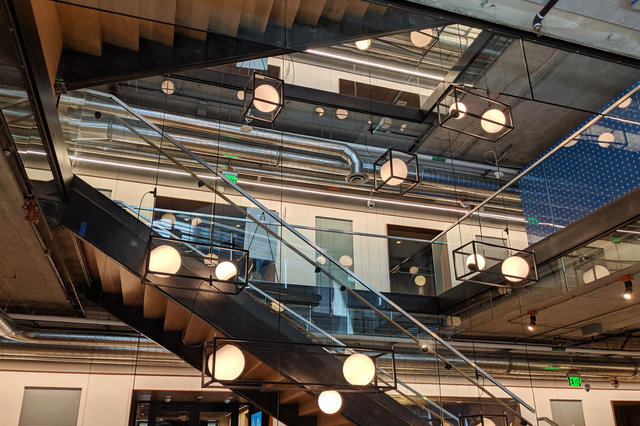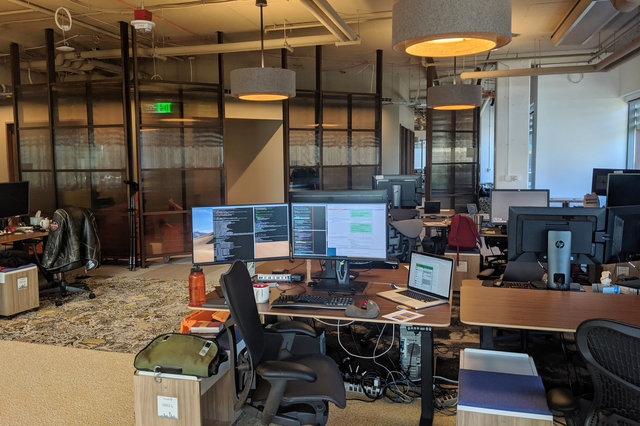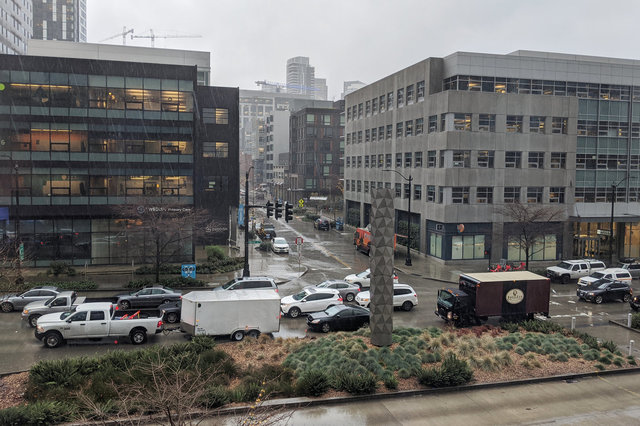Driving
Started: 2019-12-23 16:56:35
Submitted: 2019-12-23 21:03:58
Visibility: World-readable
In which the intrepid narrator rants about bus reliability in Seattle
In August, Google finally executed the first wave of the long-planned move of its Seattle office from Fremont to South Lake Union. This new campus features four brand-new buildings on two city blocks, built for Google by Paul Allen's Vulcan Real Estate, across the street from MoHAI within a block of the lake. (Rumor is that Google got the space because Amazon — the largest office-space holder in South Lake Union — wasn't willing to pay for the lake-front property.) The campus now holds all of Google Cloud in Seattle — and even though I no longer work for Cloud I'm still caught up in the move because all of SRE reports through the Cloud VP for obscure historical reasons.
The new office has a lot going for it. It looks nice, with interesting design and a four-story-tall open-stair shaft cutting through most of the building (oddly skipping the first and sixth floors of the building), and good views of Lake Union from the north side of the building. Even though it still relies on hellish open-plan offices (and engineering management claims to have no idea why I find open-plan offices intolerable), the desk areas are at least arranged with traffic flows in hallways separate from the desks, behind partitions that provide at least a psychological barrier, as well as blocking some noise and sight lines. (This, at least, is substantially better than the hellhole open-plan office I spent the past year in, in a temporary building in Fremont where my desk sat immediately opposite a large conference room where random people would come by and congregate outside the door for their meeting, then exit and continue their distracting conversations while walking down the tiny hallway defined only by the lack of desks.)
(One of the neighboring Ads SRE teams has a clown fish in an aquarium in their office space. I joked that the clown fish wasn't really provisioned with appropriate redundancy, at n+1; and the nearest SRE pointed out that it is provisioned at n+1 because n equals zero because clown fish aren't actually an essential component of the office.)
But with the move into an urban environment came a problem of parking. The City of Seattle restricts parking in new construction, allowing Google to only build something like 125 parking spaces for 650 people in my building. Google responded by charging $12/day for parking in the on-site garage, and added a $7/day incentive for taking any kind of transit to work (or really, any commute that doesn't involve parking in the garage).
The only problem is that the bus system in Seattle is objectively terrible. Most transit in Seattle is built radially through the central business district, a mile to the south. There is only one bus line that plausibly works to get me from my house in Wallingford to South Lake Union, #62. Getting there involves almost as much walking as a walk to Fremont, plus an indeterminate wait for the bus, and then I actually have to ride the crowded bus on its many stops through crowded streets.
King County Metro publishes an annual SLO report for the system, breaking down whether an individual bus route is operating within its service criteria. The report is a fascinating look into how the system evaluates itself: per Appendix A (Priority 2), an individual bus is considered "on time" if it arrives "up to 1.5 minutes before the scheduled time and up to 5.5 minutes after the scheduled time". That is not an indicator that fills me with joy, because it suggests that, if I am to trust the schedule, I should expect the bus to show up sometime within a 7-minute window.
As an SRE at Google, I am used to SLOs starting with more than one 9. Most generally-available services at Google have SLOs that start at 99.9% available. King County Metro's SLO does not start with a 9 — for all-day reliability, only 80% of the buses should be on time (remember, that's less than 5 minutes late) — and the afternoon peak doesn't even start with a 7, only 65% of buses need to be on time to meet their SLO.
Appendix F breaks this down into route-level reliability, and on this chart we see that route #62 is late all the time — even by the very low standards that the bus system has already set up for itself. Bus 62 is late 23% of the time all day long, and 38% of the time during the afternoon peak.
So I honestly don't know how I'm supposed to use a bus system when (a) I can't count on the schedule being accurate, and (b) I can show up at the stop and wait seven minutes (median, based on my real-life empirical data) only for the bus to show up too full for me to board 50% of the time.
As a customer, this is not an SLO that makes me happy, even if the bus system were able to meet it — and they (by their own report) do not even meet it, for any segment of the day, for the bus that I have to take.
In the interest of gathering data, not anecdotes, for the last three months I've been recording the timing of my bus commutes. The median amount of time I spend waiting for the bus in the morning is just over two minutes, which is better than one might expect given that the 62 bus is timetabled to arrive every six to seven minutes in the morning. My spreadsheet does not record how often I can get a seat, but anecdotally I feel like I can get a seat most of the time, but it's often a crowded seat at the back of the bus; and by the time my bus arrives in SLU the bus is standing-room-only. If I can get a seat I don't have enough space on the bus to do much of anything; if I'm lucky I can pull out my phone and read Twitter or play Pokemon Go. My median morning commute is 33 minutes; the 75th percentile is 36 minutes.
In the evening, I spend a median of 7 minutes, 44 seconds waiting at the stop for the bus at Dexter and Roy St — and then, about half the time, the bus is too full to even stop and open its doors so I can board the bus. My median evening commute is 38 minutes; the 75th percentile is 42 minutes.
(I am aware of the constraints placed on buses operating in the road network of South Lake Union — especially buses trying to cross the Mercer Mess. From personal observation much of the time that the bus spends stuck in traffic is right around Mercer, and much of that is because vehicles on Mercer consistently block the box, or vehicles on cross streets pile up trying to turn onto Mercer, making it difficult to merely cross the street. Fixing this would require changing infrastructure to add protected bus lanes to make it easier for buses to cross Mercer, and legal changes to make it easier to ticket drivers that block the box. All of this requires concerted effort by state and local governments, effort that Google is uninterested in pursuing, despite making the deliberate choice to drop several thousand people in South Lake Union with an inadequate transit system, then act surprised when we discover that the system is inadequate.)
And then there's the rain.
In the summer, when it's not raining, the commute is tolerable, if not ideal. In the winter, when it rains more often than not, I can't handle being out in the rain for very long, because when it rains I get wet, and when I get wet I get cold, and when I get cold I get miserable, which drives me into a self-reinforcing negative spiral of depression. So I drive to work, in desperate hope of avoiding getting even more depressed, paying $12/day for parking — and I get to work twenty minutes faster.
(I assert that, as popularly specified, the "Seattle Freeze" doesn't really exist — I get greeted by random people on the street at least as often as other cities I've lived in. But there are two things which makes me feel especially unwelcome in Seattle: No one is willing to admit that they don't like the rain, or that the gloomy winter climate depresses them; and no one seems to like California and its residents (or, at least, admit that they like California). This, more than anything else, makes me feel like Seattle is not my place these are not my people and I don't (and will never) belong here.)
For right now, I will drive to work if it's raining, or if I have an errand to run, or if (in a hopefully-clever bit of temptation bundling) I go running in the morning. (The last rule has encouraged me to run more often — just in time to slack off over the holidays.) This, I hope, might be enough to last until I can go visit the sun again.






